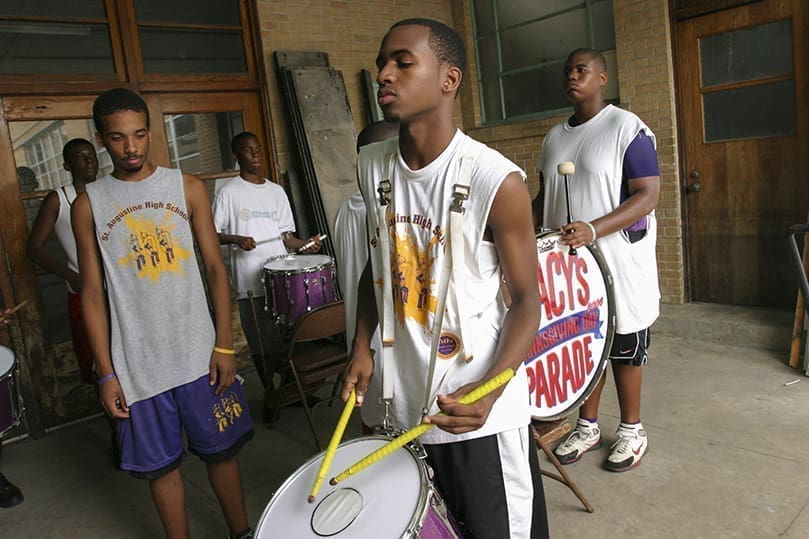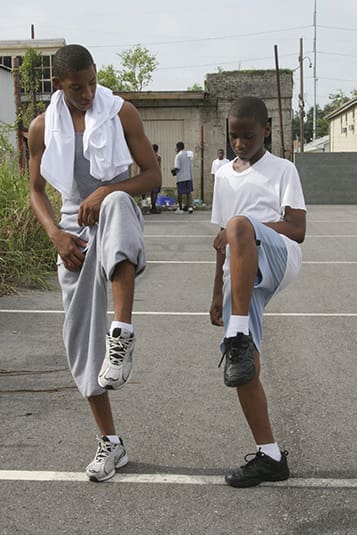 Photo By Michael Alexander
Photo By Michael Alexander
New Orleans
Famed Marching Band Returns With ‘Sweet Relief’
By ERIKA ANDERSON, Staff Writer | Published August 24, 2006
It’s a sweltering hot Louisiana day in late July. The sun is beating down upon the heads of the 70 or so teenage boys standing on the asphalt across the street from their school.
Their faces are set in determination, though beads of sweat trace lines down their foreheads and cheeks. As their instructors yell commands, they again step into their formations and begin to march, knees high as they were taught.
Later in the day, outside of the school’s gymnasium, the quick rat-a-tat-tat beat of the drum line echoes across the parking lot. It’s a sound that symbolizes a new hope for St. Augustine School and for the entire city of New Orleans.
Daily practice for the nationally recognized band, known as the “Marching 100,” has begun. The members of the band from this all-boys, historically African-American Catholic high school compare these practice days to boot camp. But for many, the hard work, sweat and sore muscles these boys experience daily is but sweet relief and a return to a new sense of normalcy.
Affectionately referred to as “St. Aug,” the school sits in an area of New Orleans that was ravaged by flooding after Hurricane Katrina in August 2005. The school itself suffered when the first floor was flooded, and additional damage was sustained when more than 300 people took refuge at the school. The school’s brand-new band room was all but destroyed, including many instruments and the Marching 100’s uniforms.
Last year as students were displaced and scattered across the country, the St. Aug band, which plays in eight to 10 Mardi Gras parades each year, was silenced. Instead, students at three schools including St. Augustine joined together to create one school, known as the MAX school. The school formed a marching band, but for several of the St. Aug boys, it just wasn’t the same.

Senior mellophone player Reginald Alexander, left, works with first year marching band member Jeremy Slack during practice. Photo By Michael Alexander
Kenneth Caldwell plays the cymbals. As the drum line practices, the cymbal players clap in beat, twirling their arms around. The cymbals were a casualty of the hurricane, and until they can be replaced, the boys who play the instrument are forced to simulate their part in the performances.
Caldwell said he lost everything in the hurricane and had to move to Texas with his family.
“I was hurting,” the 17-year-old senior said. “I really wanted to be here. I have nothing left, but I have this band. It’s my everything. Without this, I would have had nothing to come back to. But I’ve learned you can lose everything, and this one thing makes up for it all.”
Caldwell isn’t the only one who feels this way.
Virgil Tiller, himself a 1995 graduate of St. Aug and member of the famed band, is the new band director. Students have sacrificed to return to play in the band, he said.
“Some of them have left their parents in other states and have come back to New Orleans and are living with other people just to be a part of the band,” he said. “You have to really respect that and really respect the hope that they have.”
Tiller understands firsthand the significance of the band to his students.
“Being a part (of this band) really kept me out of trouble,” he said. “It taught me discipline, and everything I do in my life I base on the principles I learned here at St. Aug.”
For 55 years, Edwin Hampton doled out that discipline. The creator and band director-emeritus started at the school when it opened as the first Catholic high school in New Orleans for African-American boys in 1951. To this day, he still keeps a watchful eye over the program he began. He feels a sense of renewal that the band will again be taking the field, he said.
“Things are really starting to look like we’re on a good roll,” he said. “These kids are very eager, and it gives a lot of us hope. I’ve learned that if you challenge them and give them a chance, the kids have that spirit and can accomplish a lot of goals.”

St. Augustine High School Band section leaders make sure their lines are straight before stepping off. Photo By Michael Alexander
Hampton led his band while they played in both the Macy’s Thanksgiving Day Parade in New York and in the Rose Bowl Parade in Pasadena, Calif. The band and school also boast impressive alumni, including Victor Goines, the director of jazz studies at The Julliard School, Dean Baquet, editor of the Los Angeles Times, and former New Orleans Mayor Sidney Barthelemy. Ninety percent of St. Aug graduates go on to college.
Kendra Every has a son in the seventh grade who has just begun practicing with the St. Aug band. She’s thrilled to see the return of the Marching 100.
“It’s everything to these boys. There’s no New Orleans without St. Aug and there’s definitely no Mardi Gras. These kids are working so hard to make a fresh start. Even though the school’s not totally together, they’re still coming out here every morning to practice.”
Tiller, too, is proud of his students and said though they are a bit short now, he hopes to recruit more members so the band can live up to its Marching 100 name.
“I really want to try to get at least 96 on the field,” he said. “This band is an integral part of the history of the city, and it means a lot to a lot of people. We’re really glad to be back.”
The St. Aug Marching 100 is in need of donations. All the members’ uniforms were destroyed, and replacement uniforms cost around $500 each. To make a donation, visit the school’s Web site at www.purpleknights.com.